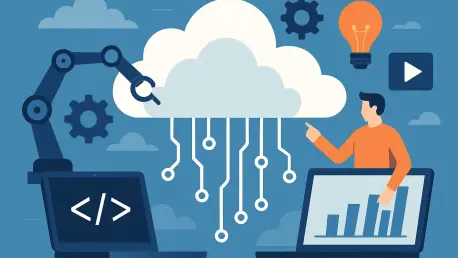In an era where cloud computing drives the backbone of modern business, the challenge of managing sprawling digital infrastructures has never been more daunting, and yet, a visionary specialist named Gogulakrishnan Kalivararthan is leading a transformative charge with groundbreaking automation strategies. As organizations race to scale their cloud presence, many stumble under the weight of manual processes that breed inconsistency, delays, and ballooning costs. Traditional methods often leave teams grappling with errors and inefficiencies that hinder growth in a fiercely competitive digital landscape. Gogulakrishnan has emerged as a beacon of innovation, tackling these persistent hurdles with a forward-thinking approach that leverages cutting-edge tools to redefine operational excellence. His work not only addresses immediate technical pain points but also sets a new benchmark for how cloud environments can be managed with precision and agility, promising a future where automation is the cornerstone of success.
Unpacking the Struggles of Manual Cloud Systems
The reliance on manual cloud management has long been a thorn in the side of organizations aiming to expand their digital footprint, as it introduces a host of inefficiencies that can cripple progress. Tasks like provisioning resources by hand often lead to configuration drift, where environments become inconsistent over time, creating a ripple effect of errors and troubleshooting nightmares. Deployment timelines stretch unnecessarily, stalling critical projects and frustrating stakeholders who depend on rapid rollouts to stay ahead. Moreover, the financial toll is staggering, with over-provisioning and forgotten resources draining budgets through unnoticed waste. Gogulakrishnan Kalivararthan has pinpointed these issues as fundamental barriers, emphasizing that in an age of rapid technological advancement, clinging to outdated methods is a recipe for stagnation. His insights reveal a pressing need for systemic change, urging businesses to rethink their approach before inefficiencies spiral out of control and jeopardize competitiveness.
Compounding these challenges is the sheer scale of modern cloud demands, which manual processes are ill-equipped to handle effectively, often leaving teams overwhelmed by complexity. As organizations grow, the number of resources and environments multiplies, turning what was once a manageable task into a labyrinth of potential missteps. Human error becomes inevitable when configurations are handled without standardization, leading to security gaps or compliance failures that can have dire consequences. Gogulakrishnan’s analysis underscores that such labor-intensive methods are unsustainable, particularly when agility is a key differentiator in today’s market. The cost of delayed responses to market shifts or customer needs can be catastrophic, pushing companies to seek solutions that eliminate these bottlenecks. His work highlights a critical turning point, where the transition from manual to automated systems isn’t just an upgrade but a necessity for survival in a digital-first world.
Harnessing the Power of Infrastructure-as-Code
At the heart of Gogulakrishnan Kalivararthan’s transformative vision lies Infrastructure-as-Code (IaC), a methodology that reimagines cloud management by converting infrastructure into version-controlled, repeatable code to eliminate human error. This approach ensures uniformity across diverse environments, preventing the inconsistencies that plague manual setups. By employing robust tools like Terraform, which offers multi-cloud flexibility, and Azure Resource Manager (ARM) templates for precise, platform-specific configurations, Gogulakrishnan crafts solutions tailored to organizational needs. Security protocols, compliance requirements, and best practices are seamlessly embedded into the code from the start, reducing vulnerabilities before they arise. His strategic foresight in integrating IaC with Continuous Integration/Continuous Deployment (CI/CD) pipelines allows infrastructure to evolve in lockstep with application updates, fostering a dynamic and responsive system that traditional methods simply cannot match.
Beyond technical implementation, Gogulakrishnan’s adoption of IaC represents a paradigm shift in how cloud infrastructure can support broader business goals, blending efficiency with strategic innovation. This method empowers teams to deploy resources rapidly without sacrificing accuracy, as every change is tracked and versioned like software code, enabling rollbacks if issues occur. The automation of repetitive tasks frees up valuable human capital to focus on higher-level problem-solving and creativity, rather than getting bogged down in mundane configurations. Additionally, by codifying cost-control measures such as resource tagging and right-sizing directly into workflows, wasteful spending is curtailed at the source. Gogulakrishnan’s expertise demonstrates that IaC is not merely a tool but a foundational shift, aligning technical precision with the agility required to navigate the complexities of modern cloud demands while maintaining a competitive edge in a fast-evolving landscape.
Driving Tangible Results Through Automation
The impact of Gogulakrishnan Kalivararthan’s automation strategies is nothing short of remarkable, as evidenced by concrete metrics that showcase substantial improvements in both efficiency and financial performance for organizations under his guidance. Reports indicate a staggering 60% reduction in manual provisioning efforts, allowing teams to redirect their focus toward strategic initiatives rather than tedious, error-prone tasks. Deployment timelines have been slashed by 50%, enabling businesses to roll out critical updates and services at a pace that keeps them ahead of market demands. Perhaps most striking is the financial relief, with annual savings reaching up to $1.5 million in certain cases, achieved by minimizing errors and optimizing resource allocation. These figures paint a clear picture of how automation transcends mere convenience, becoming a powerful lever for operational excellence and a vital asset in maintaining relevance within the high-stakes digital economy.
Delving deeper into these outcomes, it becomes evident that Gogulakrishnan’s methods deliver benefits that ripple across entire organizations, reshaping not just workflows but also bottom-line priorities. The drastic cut in deployment times translates to faster time-to-market for products and services, a crucial factor when customer expectations shift rapidly. Error reduction through automated consistency checks means fewer costly downtimes or security breaches, safeguarding both reputation and revenue. Furthermore, the savings from precise resource management allow companies to reinvest in innovation, fueling growth rather than merely covering inefficiencies. Gogulakrishnan’s influence through these measurable gains proves that automation is a transformative force, bridging the gap between technical capability and business objectives. His work serves as a compelling case study for any organization looking to harness cloud technology without being weighed down by its inherent complexities.
Redefining the Horizon of Digital Infrastructure
Gogulakrishnan Kalivararthan’s contributions extend far beyond immediate technical fixes, as they spark a profound cultural shift within organizations, encouraging a mindset rooted in precision, adaptability, and relentless improvement. By championing automation, he inspires teams to abandon outdated, labor-intensive habits and embrace a proactive stance toward cloud management. This change in perspective fosters collaboration across departments, aligning IT operations with broader business strategies to ensure that infrastructure supports overarching goals. His emphasis on embedding agility into every process means companies are better equipped to pivot in response to emerging trends or disruptions. Gogulakrishnan’s vision establishes a precedent where technology serves as an enabler of innovation, not a barrier, positioning automation as the bedrock upon which future-ready enterprises are built in an increasingly digital world.
Looking ahead, the standards set by Gogulakrishnan offer a roadmap for navigating the evolving challenges of cloud operations, urging businesses to prioritize automation as a non-negotiable component of their strategy. His methodologies provide actionable insights, encouraging the adoption of tools like IaC to streamline processes and enforce governance over sprawling resources. The focus on cost optimization and scalability serves as a reminder that financial discipline must accompany technical advancements to sustain long-term growth. As cloud environments grow more intricate, the principles he champions—consistency, speed, and strategic alignment—will remain guiding lights for organizations aiming to thrive. Reflecting on his impact, it’s clear that the benchmarks he set reshape expectations, leaving a legacy of efficiency that continues to inspire systemic change and innovation across the industry.









